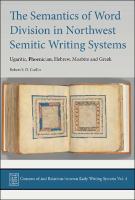In der letzten Zeit sind u.a. diese frei verfügbaren Titel erschienen:
Approaches to Arabic Popular Culture
Peter Konerding / Felix Wiedemann / Lale Behzadi | https://doi.org/10.20378/irb-49890
Over recent years, Arabic popular culture has become a focal point of West Asian and North African studies. Most of the new research dealing with it concentrates on the ‘popular’ as opposed to an intellectual ‘high’ culture far from the harsh and hierarchically organized reality many Arabic-speaking societies face today. Popular cultural practices are thus seen as a rejection of the elite and a stance against those who have ‘something to loose’ within paralyzed and conservative communities. Albeit not denying the subversive political potential associated with these practices, this volume intends to take a more nuanced and broader perspective. Arabic popular culture might engage with emancipatory claims, but it might as easily follow the capitalist rulebook of global marketing. It might fight against oppressive authorities, yet it can equally become their symbol.
Approaches to Arabic Popular Culture therefore closely looks at the aesthetic implications of a topic ranging from Lebanese hip hop over Algerian pop novels to jihadi chants in the ‘Islamic State’ as well as from Egyptian mahraganāt music over sarcastic stories about hash dens and time travel in downtown Cairo to Saudi-Arabian YouTube-influencers. Thus, the theoretical scope widens and the reader is taken on a delightful journey to the unsettling pleasures of contemporary Arabic art and culture.
All structures great and small. On copular sentences with shì in Mandarin
H. Cheng | https://hdl.handle.net/1887/3206651
This dissertation provides a description and analysis of the Mandarin copula shì and copular structures containing it. On the basis of a comprehensive description of the syntactic distribution of shì and properties of different types of copular sentences (predicational, specificational, and equative), this study proposes a unified structural analysis for predicational and specificational copular sentences in Mandarin.It is proposed that shì is a functional element in the structure of the clause. Importantly, shì is not a verb, and copular structures in Mandarin contain no verb phrase at all, which is consistent with proposals about pronominal copular elements in other languages. Specificational copular sentences are analysed as inverted predicational copular sentences, derived via predicate inversion. This analysis captures both the underlying similarities and the differences between the two types of copular sentences. It is also pointed out that the third type of copular sentences, equatives, is clearly distinct from both predicational and specificational copular sentences and should thus be analysed in a different way.The dissertation also proposes that tense is not always syntactically expressed in Mandarin copular structures. While sentences with a stage-level predicate express tense syntactically, those with an individual-level predicate do not.
The semantics of word division in West Semitic writing systems
Robert S.D. Crellin | https://directory.doabooks.org/handle/20.500.12854/74540
Much focus in writing systems research has been on the correspondences on the level of the grapheme/phoneme. Seeking to complement these, this monograph considers the targets of graphic word-level units in natural language, focusing on ancient North West Semitic (NWS) writing systems, principally Hebrew, Aramaic, Phoenician and Ugaritic. While in Modern European languages word division tends to mark-up morphosyntactic elements, in most NWS writing systems word division is argued to target prosodic units, whereby written ‘words’ consist of units which must be pronounced together with a single primary accent or stress. This is opposed to other possibilities including Semantic word division, as seen in Middle Egyptian hieroglyphic. The monograph starts by considering word division in a source where, unlike the rest of the material considered, the phonology is well represented, the medieval tradition of Tiberian Hebrew and Aramaic. There word division is found to mark-up ‘minimal prosodic words’, i.e. units that must under any circumstances be pronounced together as a single phonological unit. After considering the Sitz im Leben of such a word division strategy, the monograph moves on to compare Tiberian word division with that in early epigraphic NWS, where it is shown that orthographic wordhood has an almost identical distribution. The most economical explanation for this is argued to be that word division has the same underlying basis in NWS writing since the earliest times. Thereafter word division in Ugaritic alphabetic cuneiform is considered, where two word division strategies are identified, corresponding broadly to two genres of text, poetry and prose. ‚Poetic‘ word division is taken as an instance of mainstream ‘prosodic word division’, while the other is morphosyntactic in scope anticipating later word division strategies in Europe by several centuries. Finally, the monograph considers the digital encoding of word division in NWS texts, especially the difficulties, as well as potential solutions to, the problem of marking up texts with overlapping, viz. morphosyntactic and prosodic, analyses.


